Kong Aik Lee
Nes2Net: A Lightweight Nested Architecture for Foundation Model Driven Speech Anti-spoofing
Apr 08, 2025Abstract:Speech foundation models have significantly advanced various speech-related tasks by providing exceptional representation capabilities. However, their high-dimensional output features often create a mismatch with downstream task models, which typically require lower-dimensional inputs. A common solution is to apply a dimensionality reduction (DR) layer, but this approach increases parameter overhead, computational costs, and risks losing valuable information. To address these issues, we propose Nested Res2Net (Nes2Net), a lightweight back-end architecture designed to directly process high-dimensional features without DR layers. The nested structure enhances multi-scale feature extraction, improves feature interaction, and preserves high-dimensional information. We first validate Nes2Net on CtrSVDD, a singing voice deepfake detection dataset, and report a 22% performance improvement and an 87% back-end computational cost reduction over the state-of-the-art baseline. Additionally, extensive testing across four diverse datasets: ASVspoof 2021, ASVspoof 5, PartialSpoof, and In-the-Wild, covering fully spoofed speech, adversarial attacks, partial spoofing, and real-world scenarios, consistently highlights Nes2Net's superior robustness and generalization capabilities. The code package and pre-trained models are available at https://github.com/Liu-Tianchi/Nes2Net.
ASVspoof 5: Design, Collection and Validation of Resources for Spoofing, Deepfake, and Adversarial Attack Detection Using Crowdsourced Speech
Feb 13, 2025Abstract:ASVspoof 5 is the fifth edition in a series of challenges which promote the study of speech spoofing and deepfake attacks as well as the design of detection solutions. We introduce the ASVspoof 5 database which is generated in crowdsourced fashion from data collected in diverse acoustic conditions (cf. studio-quality data for earlier ASVspoof databases) and from ~2,000 speakers (cf. ~100 earlier). The database contains attacks generated with 32 different algorithms, also crowdsourced, and optimised to varying degrees using new surrogate detection models. Among them are attacks generated with a mix of legacy and contemporary text-to-speech synthesis and voice conversion models, in addition to adversarial attacks which are incorporated for the first time. ASVspoof 5 protocols comprise seven speaker-disjoint partitions. They include two distinct partitions for the training of different sets of attack models, two more for the development and evaluation of surrogate detection models, and then three additional partitions which comprise the ASVspoof 5 training, development and evaluation sets. An auxiliary set of data collected from an additional 30k speakers can also be used to train speaker encoders for the implementation of attack algorithms. Also described herein is an experimental validation of the new ASVspoof 5 database using a set of automatic speaker verification and spoof/deepfake baseline detectors. With the exception of protocols and tools for the generation of spoofed/deepfake speech, the resources described in this paper, already used by participants of the ASVspoof 5 challenge in 2024, are now all freely available to the community.
On the Generation and Removal of Speaker Adversarial Perturbation for Voice-Privacy Protection
Dec 12, 2024


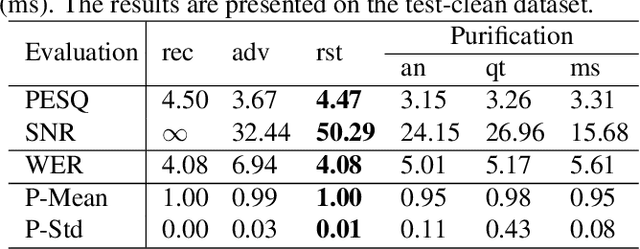
Abstract:Neural networks are commonly known to be vulnerable to adversarial attacks mounted through subtle perturbation on the input data. Recent development in voice-privacy protection has shown the positive use cases of the same technique to conceal speaker's voice attribute with additive perturbation signal generated by an adversarial network. This paper examines the reversibility property where an entity generating the adversarial perturbations is authorized to remove them and restore original speech (e.g., the speaker him/herself). A similar technique could also be used by an investigator to deanonymize a voice-protected speech to restore criminals' identities in security and forensic analysis. In this setting, the perturbation generative module is assumed to be known in the removal process. To this end, a joint training of perturbation generation and removal modules is proposed. Experimental results on the LibriSpeech dataset demonstrated that the subtle perturbations added to the original speech can be predicted from the anonymized speech while achieving the goal of privacy protection. By removing these perturbations from the anonymized sample, the original speech can be restored. Audio samples can be found in \url{https://voiceprivacy.github.io/Perturbation-Generation-Removal/}.
* 6 pages, 3 figures, published to IEEE SLT Workshop 2024
MoMuSE: Momentum Multi-modal Target Speaker Extraction for Real-time Scenarios with Impaired Visual Cues
Dec 11, 2024Abstract:Audio-visual Target Speaker Extraction (AV-TSE) aims to isolate the speech of a specific target speaker from an audio mixture using time-synchronized visual cues. In real-world scenarios, visual cues are not always available due to various impairments, which undermines the stability of AV-TSE. Despite this challenge, humans can maintain attentional momentum over time, even when the target speaker is not visible. In this paper, we introduce the Momentum Multi-modal target Speaker Extraction (MoMuSE), which retains a speaker identity momentum in memory, enabling the model to continuously track the target speaker. Designed for real-time inference, MoMuSE extracts the current speech window with guidance from both visual cues and dynamically updated speaker momentum. Experimental results demonstrate that MoMuSE exhibits significant improvement, particularly in scenarios with severe impairment of visual cues.
NTU-NPU System for Voice Privacy 2024 Challenge
Oct 03, 2024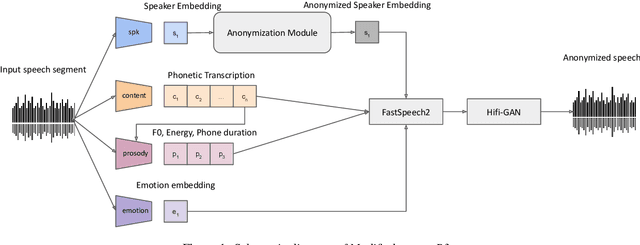

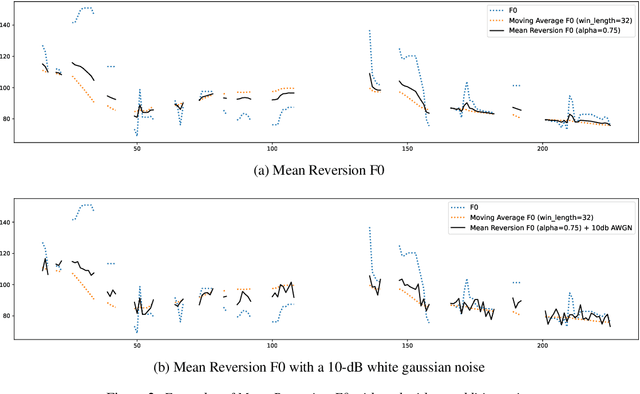

Abstract:In this work, we describe our submissions for the Voice Privacy Challenge 2024. Rather than proposing a novel speech anonymization system, we enhance the provided baselines to meet all required conditions and improve evaluated metrics. Specifically, we implement emotion embedding and experiment with WavLM and ECAPA2 speaker embedders for the B3 baseline. Additionally, we compare different speaker and prosody anonymization techniques. Furthermore, we introduce Mean Reversion F0 for B5, which helps to enhance privacy without a loss in utility. Finally, we explore disentanglement models, namely $\beta$-VAE and NaturalSpeech3 FACodec.
On the effectiveness of enrollment speech augmentation for Target Speaker Extraction
Sep 15, 2024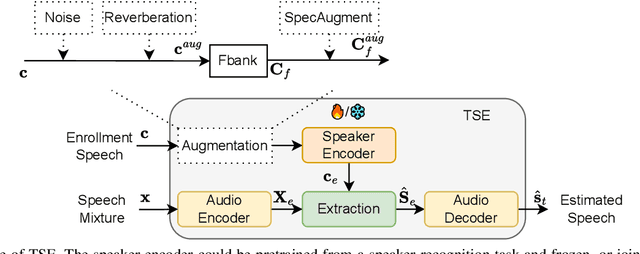
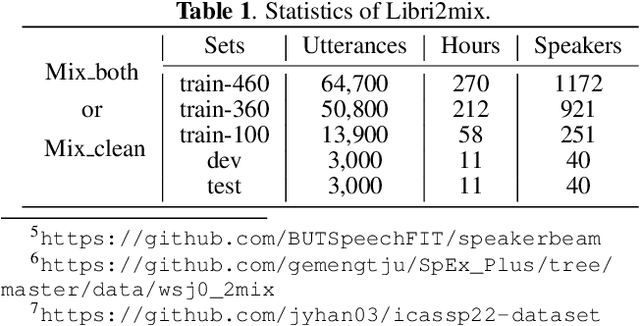
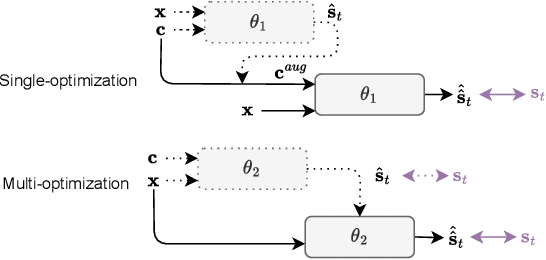
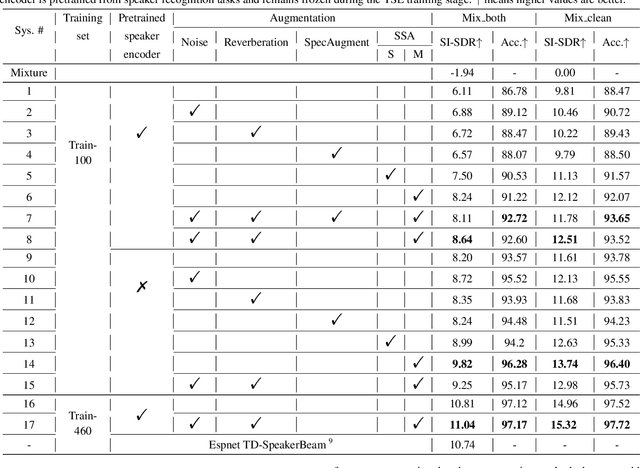
Abstract:Deep learning technologies have significantly advanced the performance of target speaker extraction (TSE) tasks. To enhance the generalization and robustness of these algorithms when training data is insufficient, data augmentation is a commonly adopted technique. Unlike typical data augmentation applied to speech mixtures, this work thoroughly investigates the effectiveness of augmenting the enrollment speech space. We found that for both pretrained and jointly optimized speaker encoders, directly augmenting the enrollment speech leads to consistent performance improvement. In addition to conventional methods such as noise and reverberation addition, we propose a novel augmentation method called self-estimated speech augmentation (SSA). Experimental results on the Libri2Mix test set show that our proposed method can achieve an improvement of up to 2.5 dB.
Towards Quantifying and Reducing Language Mismatch Effects in Cross-Lingual Speech Anti-Spoofing
Sep 12, 2024Abstract:The effects of language mismatch impact speech anti-spoofing systems, while investigations and quantification of these effects remain limited. Existing anti-spoofing datasets are mainly in English, and the high cost of acquiring multilingual datasets hinders training language-independent models. We initiate this work by evaluating top-performing speech anti-spoofing systems that are trained on English data but tested on other languages, observing notable performance declines. We propose an innovative approach - Accent-based data expansion via TTS (ACCENT), which introduces diverse linguistic knowledge to monolingual-trained models, improving their cross-lingual capabilities. We conduct experiments on a large-scale dataset consisting of over 3 million samples, including 1.8 million training samples and nearly 1.2 million testing samples across 12 languages. The language mismatch effects are preliminarily quantified and remarkably reduced over 15% by applying the proposed ACCENT. This easily implementable method shows promise for multilingual and low-resource language scenarios.
NPU-NTU System for Voice Privacy 2024 Challenge
Sep 06, 2024

Abstract:Speaker anonymization is an effective privacy protection solution that conceals the speaker's identity while preserving the linguistic content and paralinguistic information of the original speech. To establish a fair benchmark and facilitate comparison of speaker anonymization systems, the VoicePrivacy Challenge (VPC) was held in 2020 and 2022, with a new edition planned for 2024. In this paper, we describe our proposed speaker anonymization system for VPC 2024. Our system employs a disentangled neural codec architecture and a serial disentanglement strategy to gradually disentangle the global speaker identity and time-variant linguistic content and paralinguistic information. We introduce multiple distillation methods to disentangle linguistic content, speaker identity, and emotion. These methods include semantic distillation, supervised speaker distillation, and frame-level emotion distillation. Based on these distillations, we anonymize the original speaker identity using a weighted sum of a set of candidate speaker identities and a randomly generated speaker identity. Our system achieves the best trade-off of privacy protection and emotion preservation in VPC 2024.
Malacopula: adversarial automatic speaker verification attacks using a neural-based generalised Hammerstein model
Aug 17, 2024Abstract:We present Malacopula, a neural-based generalised Hammerstein model designed to introduce adversarial perturbations to spoofed speech utterances so that they better deceive automatic speaker verification (ASV) systems. Using non-linear processes to modify speech utterances, Malacopula enhances the effectiveness of spoofing attacks. The model comprises parallel branches of polynomial functions followed by linear time-invariant filters. The adversarial optimisation procedure acts to minimise the cosine distance between speaker embeddings extracted from spoofed and bona fide utterances. Experiments, performed using three recent ASV systems and the ASVspoof 2019 dataset, show that Malacopula increases vulnerabilities by a substantial margin. However, speech quality is reduced and attacks can be detected effectively under controlled conditions. The findings emphasise the need to identify new vulnerabilities and design defences to protect ASV systems from adversarial attacks in the wild.
ASVspoof 5: Crowdsourced Speech Data, Deepfakes, and Adversarial Attacks at Scale
Aug 16, 2024



Abstract:ASVspoof 5 is the fifth edition in a series of challenges that promote the study of speech spoofing and deepfake attacks, and the design of detection solutions. Compared to previous challenges, the ASVspoof 5 database is built from crowdsourced data collected from a vastly greater number of speakers in diverse acoustic conditions. Attacks, also crowdsourced, are generated and tested using surrogate detection models, while adversarial attacks are incorporated for the first time. New metrics support the evaluation of spoofing-robust automatic speaker verification (SASV) as well as stand-alone detection solutions, i.e., countermeasures without ASV. We describe the two challenge tracks, the new database, the evaluation metrics, baselines, and the evaluation platform, and present a summary of the results. Attacks significantly compromise the baseline systems, while submissions bring substantial improvements.
 Add to Chrome
Add to Chrome Add to Firefox
Add to Firefox Add to Edge
Add to Edge